Consumer Attitudes on Artisanal Gold Mining
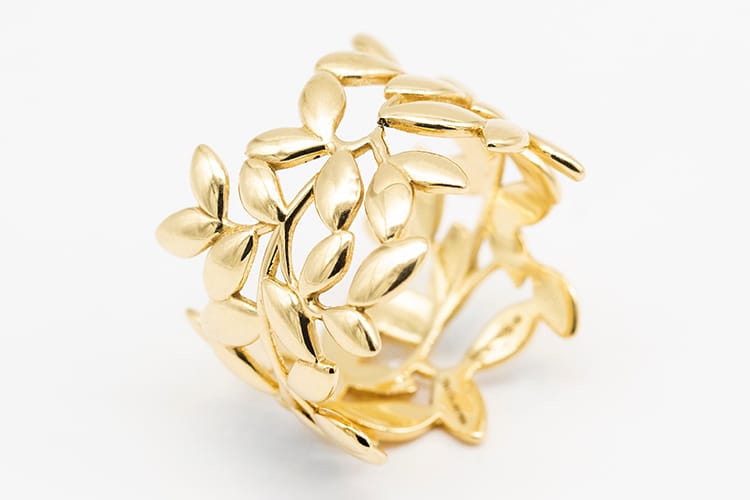
Introduction
MVI Marketing LLC (THE MVEye), commissioned by Christina T. Miller, Sustainable Jewelry Consulting, with sponsorship by Rio Grande and Alliance for Responsible Mining, conducted a November 2020 study to understand jewelry consumers’ awareness of how the gold in their jewelry came to market and their willingness to purchase responsibly sourced artisanal and small-scale (ASM) mined gold. Additionally, the goal of the study was to find out what issues with the gold supply chain resonate with respondents enough to motivate them to pay more for responsibly sourced gold, and how much more. For example, are customers motivated to pay more based on environmental concerns, labor concerns, or something else? The study was comprehensive in that respondents were asked about their favorite jewelry styles and metals, the type of retailers from which they purchase fine jewelry, the countries where they think gold is mined, and their understanding of artisanal mining, mercury, and issues facing miners.
The November 2020 survey was deployed nationwide and completed by 1,015 consumers: 73% female, 27% male; household income $50,000 and higher; ages 25-50. A requirement for participation in the survey was having purchased jewelry with a retail value greater than $200 in the past 3 years.
Methodology
Our initial hypothesis was that respondents and the average consumer had limited or cursory knowledge about mining in general and specifically about artisanal mining. Thus, we educated respondents throughout the survey on gold mining after first getting a baseline of their understanding and involvement with jewelry and shopping habits.
After an explanation of mining, we asked respondents what issues they thought miners faced, both artisanal and small-scale (ASM) and conglomerate miners.
Finally, we defined ASM Certified Responsible Gold and then asked respondents to weigh in on whether they would pay more for it and what they would choose if given a choice. For the purposes of this study, ASM-certified responsible gold was defined as gold from artisanal and small-scale gold mines that adhere to environmental, social, and economic standards, which are audited by an independent third party.
Shopping Habits
Men and women choose diamonds set in gold equally as much (54%) but men choose diamonds in sterling silver slightly more than women (46% vs 41%). Men favor all-karat gold (50%) versus women at 35%. As to where respondents shop, nearly half shop at jewelry chains like Kay, Jared, and Helzberg Diamonds, followed by high-end jewelers like Tiffany (35%) and local independent jewelers (35%).
When asked about metal preferences, overall 58% said it was extremely important with men at 65% and women at 55%, and 35% overall said somewhat important. When asked what factors into their jewelry purchase decision, design ranked first, followed by price and the material it is made with.
White gold is the clear choice of 1/4th of respondents for both self-purchase and a gift for others. Men appear to read the posted information about products (e.g. tags on jewelry) more than women (54% versus 40%) When asked if they had purchased jewelry with recycled gold, 37% said no, 30% yes, and 25% said they’ve never seen it. Given that gold is readily recycled it is very likely that consumers have unknowingly purchased jewelry made with recycled gold.
Issues That Impact Jewelry Purchasing Decisions
Before any education was provided to respondents, we asked their general concerns for several environmental/social/origin questions. Men displayed far more concern for social and environmental issues and country of origin than women on all of the issues they were asked about. Forty-six percent of men consider environmental pollution to a great extent with the same percentage of women not considering it at all. On the issue of toxic waste, 44% of men versus 30% of women considered it a lot. The results were similar for deforestation: 45% of men versus 30% of women considered it a lot. Even on the softer issues like dangerous working conditions and child labor men displayed more concern for the issues (see chart). When asked about the country of origin for jewelry, stones, and metal -again men displayed much higher concern than women in the survey.
While not as drastic as gender disparity, the younger age group (25-35) showed more concern (considered issue a lot) for the issues raised in the study than the older group (36-50). The issues where these 2 groups were further apart were jewelry and metal country of origin, while the issues where there was more agreement were child labor and human rights abuses. More surprising is the disparity in age groups for not considering an issue at all. On the issue of environmental pollution, 45% of the older age group has not considered this at all when making a purchase decision, compared to 32% of the younger age group.
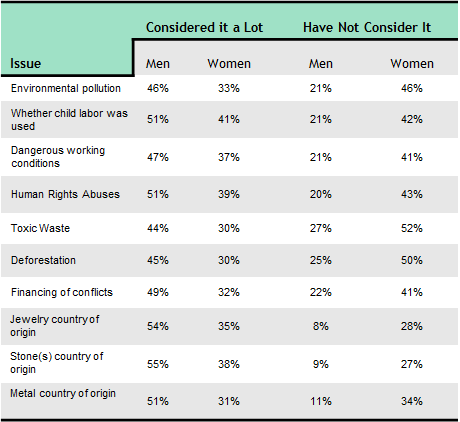
Gold Origin and Artisanal Gold: Limited Knowledge Prior to Education
To 51% of respondents, the gold origin is important: 21% say they always ask about the origin, while 31% say they like to know about the origin and it may affect their decision to purchase. To the other 49% of respondents, the origin is not very important or not important at all. Of the 21% of respondents who said they don’t care about origin; men were 9% and women 26% of that number.
The majority of respondents (42%) have no idea what artisanal gold is. Thirty-nine percent said they heard of it but don’t know what it means, and 19% said they know exactly what it means. However, of this 19%, only 57% defined it correctly: as gold from individual miners or small mines or gold mined by hand in rural impoverished areas.
Mercury is commonly used in small-scale gold mining. While 61% of respondents correctly indicated that mercury can have a toxic effect on the nervous system and cause brain damage, many respondents gave nonsensical or mundane responses such as mercury is a silver color (41%), it can freeze (15%), and completely incorrect responses: It is easy and safe to handle, 9%.
Basic Education for Respondents
Before going deeper into artisanal gold mining issues, we briefly educated respondents on the basics of gold mining:
Gold is a precious metal that has an emotional, cultural, and financial value which is different for people across the globe. Around half of all gold mined today is made into jewelry. Gold mining is a global business with operations on every continent except Antarctica. Gold is mined by extracting gold ore (metal-rich rock) from the earth’s crust. 60-70% of the world’s gold production comes from surface mines, with the remainder from underground mines that can be several miles under the earth’s surface.
Gold is mined with varying levels of mechanization – from large industrial scale multi-national corporations to medium-sized companies to individual miners. Oftentimes, individual or small-scale miners are subsistence miners, meaning they mine gold to sustain their daily needs.
When previously asked about their concern for environmental and social issues, women seemed a bit ambivalent. But, after a little bit of education, women displayed more concern for miners’ issues. Overall, 62% of respondents saw dangerous working conditions as the most pressing issue facing independent subsistence miners.
More women (65%) than men (55%) said dangerous work conditions; more women (47%) than men (35%) said local poverty around the mine site. However, more men (39%) than women (27%) said deforestation and the same for environmental pollution: men (47%) versus women (42%). Child labor ranked very low for both conglomerates and ASM miners.
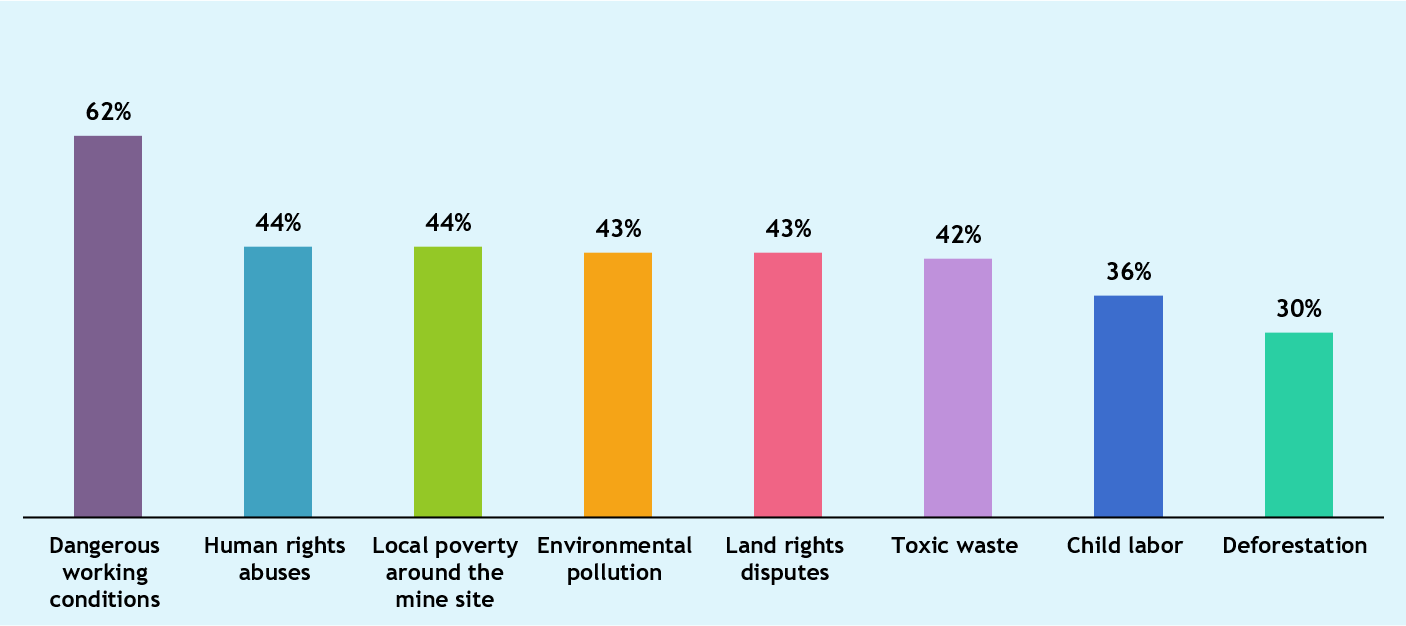
More Education on Artisanal Mining Issues
Miners working independently, using predominantly manually-intensive methods, are referred to as artisanal and small-scale mining (ASM)
It is low-tech, labor-intensive mineral processing and extraction mining that generates a living for over 100 million people living in rural and impoverished countries. Artisanal and small-scale mining (ASM) accounts for 20% of the gold mined in the world.
The fluctuation in gold prices, along with other factors such as government policies and conflict, can spur increased informal, unregulated gold mining globally. For many people in gold-rich regions, informal gold mining is often the most gainful form of work and often a pathway out of poverty. The prospect of higher earnings is attracting more informal miners to ASM.
Unfortunately, the results of this sharp increase in informal mining activities have far-reaching effects on deforestation, displacement of indigenous communities, and toxic mercury pollution of air, water, soil, and food chains. Artisanal and small-scale gold mining releases more mercury into the environment than any other sector. Children have been injured and killed when working in small-scale gold mining pits. In war, civilians have suffered enormously as abusive armed criminals have enriched themselves by exploiting gold.
Informal gold mining occurs mostly in Asia, Africa, and Latin America, particularly in areas with low levels of income and reduced levels of oversight and good governance.
Despite its issues, ASM is seen as an important sector for the socio-economic development of impoverished regions of the world. There is a way to keep artisanal and small-scale (ASM) miners working but with better and safer practices. It starts with providing useful equipment and training to increase their production while eliminating the use of mercury.
Efforts are underway to “re-educate” and “operationalize” artisanal and small-scale gold mining, leading to ASM gold being referred to as “Artisanal and Small-Scale Mined Certified Responsible Gold” by using standards for social and environmental impacts verified by independent 3rd parties.
Certified Artisanal and Small-Scale Mining is an essential pathway to mitigate negative impacts yet sustain livelihoods, increase local development, and foster local employment.
Respondents did not find that ASM Certified Responsible Gold would likely reduce pollution or the environmental impact of mining; however, they did recognize that ASM Certified Responsible Gold could positively support livelihoods, help impoverished communities, and help eliminate mercury to improve the health of miners and their families. Once consumers learn about mercury use in mining, they can recognize ASM Certified Gold’s potential to eliminate mercury use.
Which 3 positive issues in the above statement had the most impact on you? (Rank TOP 3)
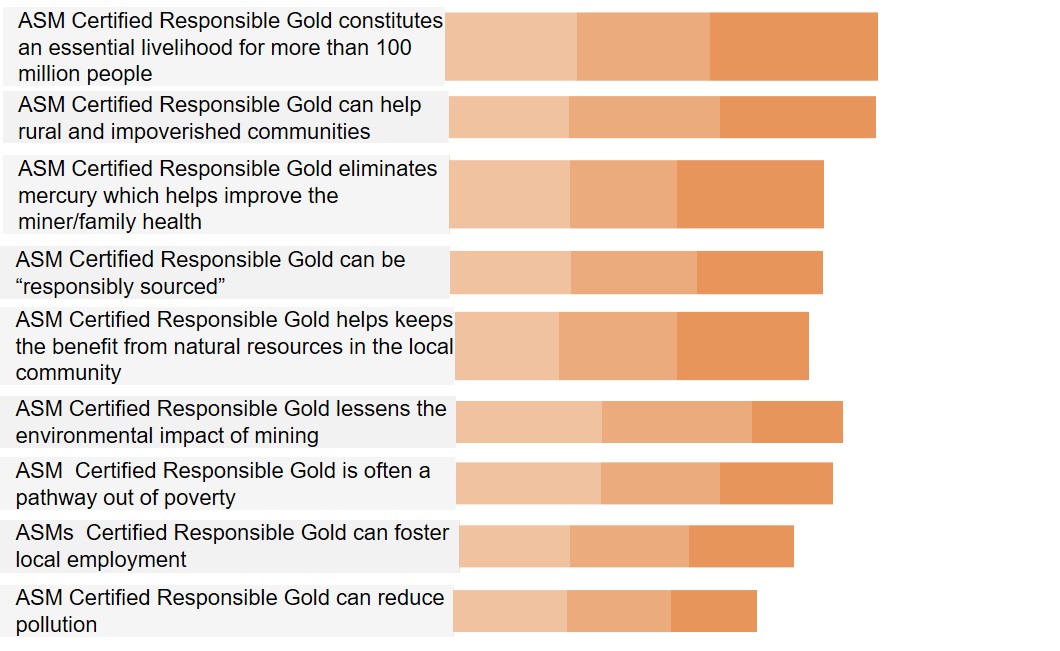
Would Consumers Pay More for ASM Certified Responsible Gold?
Yes |
54% |
Maybe |
29% |
No |
16% |
Of the yes, would you pay more response (54% overall), men were 65% and women 55% of this number, while more women (33%) said maybe versus men (21%)? Given that women are particular about style and price, this may be number is understandable. The majority of respondents (33%) would pay between 5-10% more for ASM Certified Responsible Gold. However, 41% would be willing to pay 11% or more. Interestingly, 65% of women chose 10% or under responses and 55% of men chose 11% and higher responses.
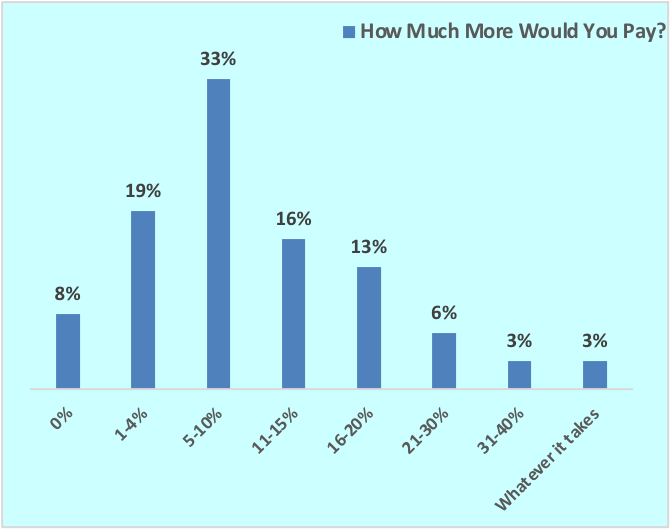
What aspect of ASM Certified Responsible Gold moves you to spend more?
Between 1/4 and 1/3 of respondents cited Knowing no children were involved and human rights were respected as the reason for choosing to spend more. That reason held for respondents answering 5-10%, 11-15%, 16-20% and 21-30%.
The response knowing that it aims to create sustainable livelihoods and economic development opportunities was the second most selected reason for spending more on ASM Certified Responsible Gold.
The response Knowing it will help protect the health and safety of mine workers was the third most cited response for paying more money.
ASM Certified Responsible Gold was not a determining factor for purchasing gold jewelry for 44% of respondents, especially for men, with 58% of them saying they would still purchase jewelry that was NOT ASM Certified Responsible Gold, versus 38% of the women. With design the top criteria for choosing fine jewelry styles, followed by price, it is no wonder there was a large number on the fence, choosing “maybe” about this issue, especially among women.
Respondents ranked which jewelry they were most likely to purchase with 45% of respondents saying they would purchase, or request jewelry made with ASM Certified Responsible Gold. Respondents would also purchase or request jewelry made with recycled gold (25%) and jewelry made with gold from industrial-scale mining conglomerates (13%). 12% were unsure. Almost 50% of younger respondents (ages 25-35) would choose ASM Certified Responsible Gold, whereas 42% of those ages 36-50 would make the same choice.
Fair Trade Is the Most Recognized Label
Fairtrade Gold was recognized by 42% of respondents while Fairmined Gold was recognized by 20%. U.S. residents are used to seeing fair trade products in various places such as grocery stores, gift shops, etc. Thirty-two percent of respondents said none of the above. Men overall are 15-20% more aware of these labels than women. Ages 25-35 overall are 6-10% more aware of these labels than ages 36-50.
When asked if they had ever made a purchase based on seeing the label, 42% of Fairtrade respondents said yes, whereas 56% of Fairmined respondents said yes.
The Path Forward
Respondents came into the study with limited knowledge about the issues facing miners, particularly small-scale artisanal miners. Women especially were initially ambivalent and said they did not consider things like environmental pollution, mercury poisoning, dangerous working conditions, and child labor.
With a little bit of education and information provided about artisanal mining and what Artisanal and Small Scale Mine (ASM) Certified Responsible Gold means, many respondents changed their thinking to the point that a majority would consider paying more for ASM Certified Responsible Gold.
The research findings are clear: marketing messages must include the story behind the gold and the cost/benefit to the consumer of buying responsibly.
Christina T. Miller Consulting (CMC) provides education, guidance, and strategy for responsible and sustainable jewelry supply chains. Learn more at ChristinaTMiller.com
Rio Grande – For nearly 80 years Rio Grande has supported the art and industry of jewelry-making with a one-stop selection backed by exemplary service. We started by selling stones, silver, and hand tools on old Route 66. Today, we also serve a global #RioJeweler community and are a leading provider of precious materials, custom services, and cutting-edge technologies. RioGrande.com
Alliance for Responsible Mining (ARM) facilitates the empowerment of artisanal and small-scale miners, their organization, and the adoption of good practices, promoting favorable environments for the inclusion of artisanal and small-scale miners in the formal economy. ASM creates voluntary standard systems for production and trade and supports the creation of responsible supply chains. Responsiblemines.org
MVI Marketing LLC (THE MVEye) – Founded in 1987, THE MVEye provides market research and strategic consulting for the global gem, jewelry and watch industries at every level of the supply chain. This is the first in a series of yearly surveys to gauge consumer acceptance of artisanally mined gold.
Source: MVI Marketing